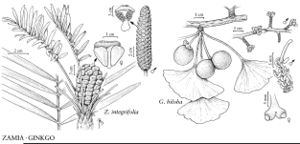Difference between revisions of "Zamia integrifolia"
in Aiton,Hort. Kew. 3: 478. 1789.
FNA>Volume Importer |
FNA>Volume Importer |
||
| Line 26: | Line 26: | ||
}}<!-- | }}<!-- | ||
| − | --><span class="statement" id="st- | + | --><span class="statement" id="st-undefined" data-properties=""><b>Stem </b>subterranean, or leaf-bearing apex exposed. <b>Leaves</b> 2–10 dm; petiole unarmed; leaflets 6–17 cm × 2–18 mm, linear, often twisted, very stiff, dark glossy green, 7–23-veined; margins often revolute, entire or with small teeth to slight denticulations near apex. <b>Pollen</b> cones generally 2–5 per plant, narrowly cylindric, 5–16 cm, tapering slightly at apex. <b>Seed</b> cones cylindric-ellipsoid, 5–19 cm, blunt at apex; ovules 2 per sporophyll. <b>Seeds</b> drupelike, oblong to ovoid, somewhat angular, 1.5–2 cm, outer coat bright orange. <b>2n</b> = 16.</span><!-- |
-->{{Treatment/Body | -->{{Treatment/Body | ||
| Line 58: | Line 58: | ||
|publication year=1789 | |publication year=1789 | ||
|special status= | |special status= | ||
| − | |source xml=https://jpend@bitbucket.org/aafc-mbb/fna- | + | |source xml=https://jpend@bitbucket.org/aafc-mbb/fna-data-curation.git/src/9216fc802291cd3df363fd52122300479582ede7/coarse_grained_fna_xml/V2/V2_587.xml |
|genus=Zamia | |genus=Zamia | ||
|species=Zamia integrifolia | |species=Zamia integrifolia | ||
| − | |||
| − | |||
| − | |||
| − | |||
| − | |||
| − | |||
| − | |||
| − | |||
| − | |||
| − | |||
| − | |||
| − | |||
| − | |||
| − | |||
| − | |||
| − | |||
| − | |||
| − | |||
| − | |||
| − | |||
| − | |||
| − | |||
| − | |||
| − | |||
| − | |||
| − | |||
| − | |||
| − | |||
}}<!-- | }}<!-- | ||
-->[[Category:Treatment]][[Category:Zamia]] | -->[[Category:Treatment]][[Category:Zamia]] | ||
Revision as of 14:24, 27 July 2019
Stem subterranean, or leaf-bearing apex exposed. Leaves 2–10 dm; petiole unarmed; leaflets 6–17 cm × 2–18 mm, linear, often twisted, very stiff, dark glossy green, 7–23-veined; margins often revolute, entire or with small teeth to slight denticulations near apex. Pollen cones generally 2–5 per plant, narrowly cylindric, 5–16 cm, tapering slightly at apex. Seed cones cylindric-ellipsoid, 5–19 cm, blunt at apex; ovules 2 per sporophyll. Seeds drupelike, oblong to ovoid, somewhat angular, 1.5–2 cm, outer coat bright orange. 2n = 16.
Habitat: Period of receptivity and maturation of seeds December–March. Hammocks, pine-oak woodlands, scrub, and shell mounds
Elevation: 0–30 m
Distribution
Fla., Ga., West Indies.
Discussion
Once common to locally abundant, Zamia integrifolia is becoming increasingly uncommon as its habitats are being destroyed. The species is now considered "endangered" in Florida.
The choice of specific epithet to use for our species follows the conclusion reached by D. W. Stevenson (1987).
Controversy has long existed over the classification of Zamia in Florida. Recent researchers, however, have concluded that only one species is present in the flora. The several binomials applied to our Zamia reflect variability in plant vigor, leaf shape, leaflet width, number of marginal teeth and veins per leaflet, and geographic distribution. Forms with wide leaflets---" Zamia umbrosa "—are restricted to coastal hammocks of northeastern Florida and southeastern Georgia and appear to be quite distinct from plants of the remainder of Florida--- Z. integrifolia and " Z. floridana." Especially robust forms have been described as " Zamia silvicola." Studies by D. B. Ward (n.d.) indicate that these features have a genetic basis, but formal recognition of these different phases as species does not lead to better understanding of the complex. The variants in Florida may have originated from introductions of divergent forms of Zamia from elsewhere. The starchy stems, after treatment to remove a poisonous principle, were a significant part of aboriginal diets, and the plants were presumably dispersed by aborigines.
Zamia angustifolia Jacquin, a species thought to be restricted to the Bahamas and eastern Cuba, was reported in southern Florida by J. K. Small (1933). No voucher specimens were cited or are known to exist. Small also reported Zamia pumila Linnaeus from Florida, although erroneously.
Selected References
None.
